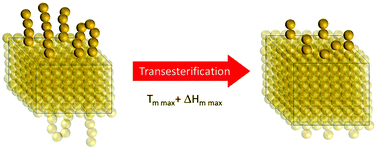Poly(l-lactide): optimization of melting temperature and melting enthalpy and a comparison of linear and cyclic species
Abstract
Twice recrystallized L-lactide was polymerized with a dozen different tin or bismuth catalysts in bulk at 160 °C for 24 h and was annealed at 150 °C afterwards. In two cases Tm values above 197.0 °C were obtained. The parameters causing a scattering of the DSC data were studied and discussed. The samples prepared with SnCl2, 2,2-dibutyl-2-stanna-1,3-ditholane (DSTL) or cyclic tin(II) bisphenyldioxide (SnBiph) were subject to annealing programs with variation of time and temperatures, revealing that the Tms did not increase. Hower, an increase of ΔHm was achieved with maximum values in the range of 93–96 J g−1 corresponding to crystallinities of around 90%. Further studies were performed with once recrystallized L-lactide. Again, those samples directly crystallized from the polymerization process showed the highest Tm values. These data were compared with the equilibrium Tm0 and ΔHm0 data calculated by several research groups for perfect crystallites. A Tm0 of 213 +/−2 °C and a ΔHm0 of 106 J g−1 show the best agreement with the experimental data. The consequences of annealing for the thickness growth of crystalites are discussed on the basis of SAXS measurements. Finally, a comparison of cyclic and linear poly(L-lactide)s is discussed.



 Please wait while we load your content...
Please wait while we load your content...